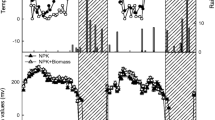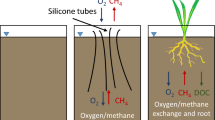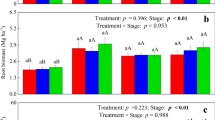Abstract
Purpose
We attempted to determine the contribution of entrapped gas bubbles to the soil methane (CH4) pool and their role in CH4 emissions in rice paddies open to the atmosphere.
Methods
We buried pots with soil and rice in four treatments comprising two atmospheric CO2 concentrations (ambient and ambient +200 μmol mol−1) and two soil temperatures (ambient and ambient +2 °C). Pots were retrieved for destructive measurements of rice growth and the gaseous CH4 pool in the soil at three stages of crop development: panicle formation, heading, and grain filling. Methane flux was measured before pot retrieval.
Results
Bubbles that contained CH4 accounted for a substantial fraction of the total CH4 pool in the soil: 26–45 % at panicle formation and 60–68 % at the heading and grain filling stages. At panicle formation, a higher CH4 mixing ratio in the bubbles was accompanied by a greater volume of bubbles, but at heading and grain filling, the volume of bubbles plateaued and contained ~35 % CH4. The bubble-borne CH4 pool was closely related to the putative rice-mediated CH4 emissions measured at each stage across the CO2 concentration and temperature treatments. However, much unexplained variation remained between the different growth stages, presumably because the CH4 transport capacity of rice plants also affected the emission rate.
Conclusions
The gas phase needs to be considered for accurate quantification of the soil CH4 pool. Not only ebullition but also plant-mediated emission depends on the gaseous-CH4 pool and the transport capacity of the rice plants.




Similar content being viewed by others
Abbreviations
- FACE:
-
Free air CO2 enrichment
- [CO2]:
-
CO2 concentration
References
Armstrong J, Armstrong W (2001) Rice and Phragmites: effects of organic acids on growth, root permeability, and radial oxygen loss to the rhizosphere. Am J Bot 88:1359–1370
Bazhin N (2010) Theory of methane emission from wetlands. Energy Environ Sci 3:1057–1072
Becker M, Asch F (2005) Iron toxicity in rice—conditions and management concepts. J Plant Nutr Soil Sci 168:558–573
Bosse U, Frenzel P (1998) Methane emissions from rice microcosms: the balance of production, accumulation and oxidation. Biogeochemistry 41:199–214
Bossio DA, Horwath WR, Mutters RG, van Kessel C (1999) Methane pool and flux dynamics in a rice field following straw incorporation. Soil Biol Biochem 31:1313–1322
Buendia LV, Neue HU, Wassmann R et al (1998) An efficient sampling strategy for estimating methane emission from rice field. Chemosphere 36:395–407
Byrnes BH, Austin ER, Tays BK (1995) Methane emissions from flooded rice soils and plants under controlled conditions. Soil Biol Biochem 27:331–339
Cao M, Dent J, Heal O (1995) Modeling methane emissions from rice paddies. Global Biogeochem Cycles 9:183–195
Cheng W, Yagi K, Xu H, Sakai H, Kobayashi K (2005) Influence of elevated concentrations of atmospheric CO2 on CH4 and CO2 entrapped in rice-paddy soil. Chem Geol 218:15–24
Cheng W, Inubushi K, Hoque MM et al (2008a) Effect of elevated [CO2] on soil bubble and CH4 emission from a rice paddy: a test by 13C pulse-labeling under free-air CO2 enrichment. Geomicrobiol J 25:396–403
Cheng W, Sakai H, Hartley AE, Yagi K, Hasegawa T (2008b) Increased night temperature reduces the stimulatory effect of elevated carbon dioxide concentration on methane emission from rice paddy soil. Global Change Biol 14:644–656
Clever HL, Young CL (1987) IUPAC solubility data series, vol27/28, methane. Pergamon, Oxford
Denier Van Der Gon HAC, Neue HU (1995) Influence of organic-matter incorporation on the methane emission from a wetland rice field. Global Biogeochem Cycles 9:11–22
Denier Van Der Gon HAC, Van Breemen N (1993) Diffusion-controlled transport of methane from soil to atmosphere as mediated by rice plants. Biogeochemistry 21:177–190
Denier Van Der Gon HAC, Van Breemen N, Neue HU et al (1996) Release of entrapped methane from wetland rice fields upon soil drying. Global Biogeochem Cycles 10:1–7
Forster P, Ramaswamy V, Artaxo P et al (2007) Changes in atmospheric constituents and in radiative forcing. In: Solomon S, Qin D, Manning M et al (eds) Climate change 2007: The physical science basis, contribution of working group I to the fourth assessment report of the intergovernmental panel on climate change. Cambridge University Press, Cambridge, pp 129–234
Fumoto T, Kobayashi K, Li C, Yagi K, Hasegawa T (2007) Revising a process-based biogeochemistry model (DNDC) to simulate methane emission from rice paddy fields under various residue management and fertilizer regimes. Global Change Biol 14:382–402
Gomez KA, Gomez AA (1984) Statistical procedures for agricultural research. Wiley, New York
Han GH, Yoshikoshi H, Nagai H et al (2005) Concentration and carbon isotope profiles of CH4 in paddy rice canopy: isotopic evidence for changes in CH4 emission pathways upon drainage. Chem Geol 218:25–40
Hansen J, Sato M, Ruedy R et al (2005) Efficacy of climate forcings. J Geophys Res 110:D18104
Himmelblau DM (1964) Diffusion of dissolved gases in liquids. Chem Rev 64:527–550
Holzapfel-Pschorn A, Seiler W (1986) Methane emission during a cultivation period from an italian rice paddy. J Geophys Res 91:11803–11814
Holzapfel-Pschorn A, Conrad R, Seiler W (1986) Effects of vegetation on the emission of methane from submerged paddy soil. Plant Soil 92:223–233
Hosono T, Nouchi I (1997) Effect of gas pressure in the root and stem base zone on methane transport through rice bodies. Plant Soil 195:65–87
Huang Y, Zhang W, Zheng X, Li J, Yu Y (2004) Modeling methane emission from rice paddies with various agricultural practices. J Geophys Res 109:D08113
Hutchinson GL, Livingston GP (2002) Soil-atmosphere gas exchange. In: Dane JH, Topp C (eds) Method of soil analysis part 4 physical method. Soil Science Society of America, Inc., Madison, pp 1159–1182
Littell RC, Milliken GA, Stroup WW, Wolfinger RD, Schabenberber O (2006) Sas® for mixed models, Cary, NC
Maeda T, Soma K (1986) Physical properties. In: Wada K (ed) Ando soils in Japan. Kyushu University Press, Fukuoka, pp 99–114
Nouchi I, Mariko S, Aoki K (1990) Mechanism of methane transport from the rhizosphere to the atmosphere through rice plants. Plant Physiol 94:59–66
Nouchi I, Hosono T, Aoki K, Minami K (1994) Seasonal variation in methane flux from rice paddies associated with methane concentration in soil water, rice biomass and temperature, and its modeling. Plant Soil 161:195–208
Okada M, Lieffering M, Nakamura H et al (2001) Free-air CO2 enrichment (FACE) using pure CO2 injection: system description. New Phytol 150:251–260
Ramaswamy V, Boucher O, Haigh J et al (2001) Radiative forcing of climate change. In: Houghton JT, Ding Y, Griggs DJ et al (eds) Climate change 2001: The scientific basis contribution of working group i to the third assessment report of the intergovernmental panel on climate change. Cambridge University Press, Cambridge, pp 349–416
Rothfuss F, Conrad R (1998) Effect of gas bubbles on the diffusive flux of methane in anoxic paddy soil. Limnol Oceanogr 43:1511–1518
Sass RL, Fisher FM, Harcombe PA, Turner FT (1990) Methane production and emission in a texas rice field. Global Biogeochem Cycles 4:47–68
Sass RL, Fisher FM, Turner FT, Jund MF (1991) Methane emission from rice fields as influenced by solar radiation, temperature, and straw incorporation. Global Biogeochem Cycles 5:335–350
Sass RL, Fisher FM Jr, Huang Y (2000) A process-based model for methane emissions from irrigated rice fields: experimental basis and assumptions. Nutr Cycl Agroecosys 58:249–258
Schimel D, Alves D, Enting I et al (1995) Radiative forcing of climate change. In: Houghton JT, Meira Filho LG, Callander BA et al (eds) Climate change 1995: The science of climate change, contribution of WG I to the second assessment report of the intergovernmental panel on climate change. Cambridge University Press, Cambridge, pp 65–132
Schink B (1997) Energetics of syntrophic cooperation in methanogenic degradation. Microbiol Mol Biol Rev 61:262–280
Schütz H, Holzapfel-Pschorn A, Conrad R, Rennenberg H, Seiler W (1989) A 3-year continuous record on the influence of daytime, season, and fertilizer treatment on methane emission rates from an italian rice paddy. J Geophys Res 94:16405–16416
Shindell DT, Faluvegi G, Bell N, Schmidt GA (2005) An emissions-based view of climate forcing by methane and tropospheric ozone. Geophys Res Lett 32:L04803
Shindell DT, Faluvegi G, Koch DM et al (2009) Improved attribution of climate forcing to emissions. Science 326:716–718
Shindell D, Kuylenstierna JCI, Vignati E et al (2012) Simultaneously mitigating near-term climate change and improving human health and food security. Science 335:183–189
Shine KP, Derwent RG, Wuebbles DJ, Morcrette J-J (1990) Radiative forcing of climate change. In: Houghton JT, Jenkins GJ, Ephraums JJ (eds) Climate change: The IPCC scientific assessment. Cambridge University Press, Cambridge, pp 41–68
Stams AJM (1994) Metabolic interactions between anaerobic-bacteria in methanogenic environments. Antonie Van Leeuwenhoek 66:271–294
Sudo S (2006) Method and instrument for measuring atmospheric gas, patent publication number 2006-275844. National Institute for Agro-Environmental Sciences, Japan
Tokida T, Miyazaki T, Mizoguchi M, Seki K (2005) In situ accumulation of methane bubbles in a natural wetland soil. Eur J Soil Sci 56:389–395
Tokida T, Miyazaki T, Mizoguchi M et al (2007) Falling atmospheric pressure as a trigger for methane ebullition from peatland. Global Biogeochem Cycles 21:GB2003
Tokida T, Miyazaki T, Mizoguchi M (2009) Physical controls on ebullition losses of methane from peatlands. In: Baird A, Belyea L, Comas X, Reeve A, Slater L (eds) Northern peatlands and carbon cycling. American Geophysical Union, Washington
Tokida T, Fumoto T, Cheng W et al (2010) Effects of free-air CO2 enrichment (FACE) and soil warming on CH4 emission from a rice paddy field: impact assessment and stoichiometric evaluation. Biogeosciences 7:2639–2653
Tokida T, Adachi M, Cheng W et al (2011) Methane and soil CO2 production from current-season photosynthates in a rice paddy exposed to elevated CO2 concentration and soil temperature. Global Change Biol 17:3327–3337
Uzaki M, Mizutani H, Wada E (1991) Carbon isotope composition of CH4 from rice paddies in Japan. Biogeochemistry 13:159–175
Van Bodegom PM, Groot T, Van Den Hout B, Leffelaar PA, Goudriaan J (2001) Diffusive gas transport through flooded rice systems. J Geophys Res 106:20861–20873
Wang B, Neue HU, Samonte HP (1997) Role of rice in mediating methane emission. Plant Soil 189:107–115
Wang B, Neue HU, Samonte HP (1999) Factors controlling diel patterns of methane emission via rice. Nutr Cycl Agroecosys 53:229–235
Wassmann R, Neue HU, Alberto MCR et al (1996) Fluxes and pools of methane in wetland rice soil with varying organic inputs. Environ Monit Assess 42:163–173
Watanabe A, Kimura M (1995) Methane production and its fate in paddy fields. VIII. Seasonal variation of methane retained in soil. Soil Sci Plant Nutr 41:225–233
Watanabe A, Kimura M (1998) Factors affecting variation in CH4 emission from paddy soils grown with different rice cultivars: a pot experiment. J Geophys Res 103:18947–18952
Watanabe A, Murase J, Katoh K, Kimura M (1994) Methane production and its fate in paddy fields. V. Fate of methane remaining in paddy soil at harvesting stage. Soil Sci Plant Nutr 40:221–230
Wilhelm E, Battino R, Wilcock RJ (1977) Low-pressure solubility of gases in liquid water. Chem Rev 52:219–262
Xu S, Jaffé PR, Mauzerall DL (2007) A process-based model for methane emission from flooded rice paddy systems. Ecol Model 205:475–491
Acknowledgements
We thank Mr. H. Iino and Mr. H. Kamimura of the Field Management Division of the National Institute for Agro-Environmental Sciences (NIAES) for technical assistance with pot preparation. We also acknowledge Ms. M. Kajiura and Dr. N. Katayanagi of NIAES and Dr. M. Matsushima of Chiba University for help with flux measurements and Drs. S. Sudo and K. Minamikawa of NIAES for assistance with the GC analysis. This research was financially supported by the Global Environment Research Program, Ministry of the Environment, Japan, and a Grant-in-Aid for Scientific Research (PD 19-7010) from the Japan Society for the Promotion of Science.
Author information
Authors and Affiliations
Corresponding author
Additional information
Responsible Editor: Tim Moore.
Rights and permissions
About this article
Cite this article
Tokida, T., Cheng, W., Adachi, M. et al. The contribution of entrapped gas bubbles to the soil methane pool and their role in methane emission from rice paddy soil in free-air [CO2] enrichment and soil warming experiments. Plant Soil 364, 131–143 (2013). https://doi.org/10.1007/s11104-012-1356-7
Received:
Accepted:
Published:
Issue Date:
DOI: https://doi.org/10.1007/s11104-012-1356-7




